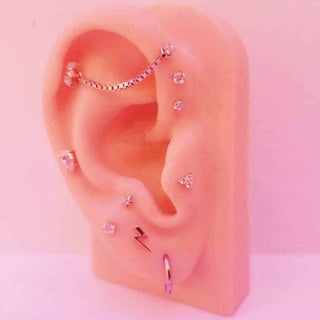Auricle Piercing 101
There are many different types of lobe piercings, but there are also quite a few types of cartilage piercings that can help you achieve a new and unique look that is different from traditional ear piercings. The auricle is in the outer portion of the ear and is located between the earlobe and helix. The area that is pierced is usually in the middle of the cartilage, meaning that you can use quite a few different types of jewelry in order to best express your individual style. There is no inherent danger in getting a cartilage piercing, contrary to the advice of those who may not be educated about the process. As long as you are keeping things clean and monitoring for signs of infection, you won’t have any issues.
Jewelry Types Used in Auricle Piercings
Due to the versatility of the auricle area, you can use quite a few different types of jewelry in order to create a unique look. Some of the more popular types of jewelry include:-
- Labret studs and other varieties
- Ear cuffs

The Auricle Pain Scale
Many ear piercings are not too painful, even on the thicker parts of the ear. The auricle is no different, and you can expect something in the realm of a 3/10 pain scale. There is always going to be some initial discomfort during the piercing process itself, but outside of that, you should only feel a bit of pain for a few days after directly at the piercing site.
Tools Used in Piercing
Every professional piercing utilizes a hollow needle made specifically for the process. This needle is pushed through the cartilage in order to create a perforation where the jewelry will be placed. Never allow your artist to use a piercing gun, as these are considered to be highly dangerous when it comes to potential infection. These tools are rarely cleaned and can harbour bacteria for a long period of time. Always ensure that your artist is usually professional equipment along with industry-standard sterilization procedures. If you feel like the equipment or location is unclean or otherwise ill-maintained, take your business elsewhere and look for something that will make you not only feel safe but valued as a customer.
Similar Cartilage Piercings
Since the auricle is located near towards the helix, getting a matching piercing in that area is something that many individuals choose to do shortly after their auricle heals. Be sure that your cartilage is fully healed before getting another piercing however, as having another one shortly after can irritate the skin and cause long term problems with healing. Your artist will be able to tell you whether or not you can get another piercing after the first one has healed fully, so don’t be afraid to go back in when you start seeing progress in the healing time.
The Process of Piercing
Piercing creates a perforation that goes through many layers of skin in order to create a space for your jewelry to be placed. Because of this, your piercer is essentially creating an open wound that can cause an infection if not taken care of properly. This is why it’s important to only get pierced by someone with experience in the type of piercing you want, as well as using the proper tools and techniques that ensure a safe and easy procedure. Outside of infection, there are some other potential issues that can crop up during the piercing process, the most obvious of which is an allergic reaction. Knowing the signs as they appear can help save the pierced area and prevent you from major discomfort.
Potential Allergic Reactions
Since our piercing jewelry is made out of quality material, there typically isn’t much to worry about when it comes to allergic reactions. If you’re using jewelry that is made from other materials, it’s important to ensure that you aren’t potentially allergic to them. Typically, any allergies present shortly after the actual piercing process, so if you notice any signs, take the jewelry out immediately and work to clean the area as best as you can in order to prevent further irritation while you get back to normal.
Cleaning Your Auricle Piercing
Saline solution is your friend when it comes to healing, and you should be using it along with cotton balls to dab the area gently in order to disinfect it. This will not only clean the area but also prevent infection from taking hold. It will take a few months for your piercing to fully heal, and the process will go a lot smoother if you know how to effectively clean it but also monitor for anything unusual.
Signs of Infection
Infection typically presents as redness, swelling, and itchiness that doesn’t go away after a few days. As well as this, you might also be experiencing scabbing or weeping from the pierced area, which is unsettling as much as unusual. Being able to catch these things early is imperative to keeping your ear area healthy. Any untreated infection can create major problems is left alone for a long period of time, so be sure to always err on the side of caution.
When to See a Doctor
Anything that is unusual or out of the ordinary while you’re healing should be noted to your doctor. By doing this, you’re setting yourself up for success in case the worst happens. Infections typically don’t take much time to heal when caught early, so it’s in your best interest to make sure that you’re keeping an eye on things each day. By staying on top of your ear healing, you’ll be able to enjoy your new piercing for a long time to come.
Ready to Explore Auricle Piercings?
At Chronic Ink Tattoo, our talented piercers are ready to help you explore any ear piercing, facial piercing, or body piercing. Stop by one of our studios today.
Tell us Your IdeaPiercing Studio Locations
Downtown Toronto
378 Yonge Street, 2nd Floor, Toronto, Ontario M5B 1S6 Directions
Midtown Toronto
252 Eglinton Ave East, 2nd Floor, Toronto, Ontario M4P 1K2 Directions
Markham
7381 Kennedy Road, Unit #105, Markham, Ontario L3R 5B5 Directions
Mississauga
100 City Centre Dr., Unit #2-311, Mississauga, Ontario L5N 2C9 Directions
Vancouver
1804 W 4th Ave, Vancouver, British Columbia V6J 1M3 Directions


